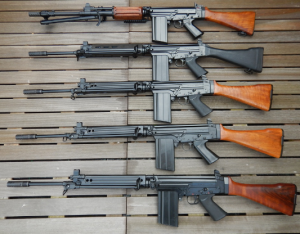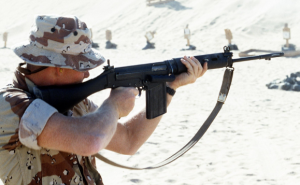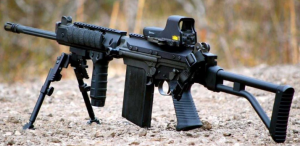Table of Contents
FN (Fabrique Nationale) de Herstal, of Belgium, was formed in 1889. They were formerly known as Fabrique Nationale d’Armes de Guerre (which stands for “National Factory of Weapons of War”), and they have been manufacturing firearms ever since the late 19th century. Over its many years, the company has grown extensively, and it now holds offices and manufacturing facilities in Europe, the U.S., and Asia. It produces pistols, rifles, shotguns, and machine guns – but we’re talking about the FAL and the FAL alone here in our FN FAL Semi-Automatic Rifle Review:
FN FAL Background and Development

The FN FAL (French: Fusil Automatique Léger, ”Light Automatic Rifle”) is a combat rifle which was developed after the end of World War II. It was designed by Dieudonné Saive and Ernest Vervier and has been produced since 1954. It is still being produced today and remains in service with many military organizations. Over 90 countries have made use, or currently make use, of the FN FAL, making it one of the most widely-used weapons in history. It has been involved in wars and military conflicts all over the world and continues to be a very popular firearm.
The first prototype of the FAL was made in 1946, and additional prototypes were designed and manufactured at the behest of the British Army. In the 1950’s, various changes were made in design and caliber, while NATO countries were looking to standardize the use of a specific rifle and cartridge. Britain was making a serious effort to standardize the FAL with NATO countries and even presented the rifle to the United States as a candidate to replace the T25. Since the 1950’s, more than 2,000,000 units of the FAL have been sold. It was originally made by FN but has also been manufacturing by several other countries under license, including Canada, Brazil, Israel, and Argentina. During the years of the Cold War, the FAL was named “The Right Arm of the Free World”, and was competing with the Soviet AKM.
The classic FAL (FAL 50.00) technical specifications are as follows:
- Cartridge – 7.62X51mm NATO
- Action – Gas-operated, short piston
- Weight – 9.48 lb.
- Length – 43 inches
- Barrel length – 21 inches
- Stock – fixed
- Magazine – 20 rounds
- Introduced – 1953
FN FAL Variants
Over the years, the FAL has been produced in a variety of designs and calibers. Many versions were discontinued, but some remain in service today. The 4 basic configurations of the FAL are:
- FAL 50.00 – fixed stock, standard barrel
- FAL 50.63 – paratrooper version with folding stock, short barrel, folding charge handle
- FAL 50.64 – folding stock, standard barrel, folding charge handle
- FAL 50.41 – fixed stock, heavy barrel, 30-round magazine

Other variants and experimental versions of the FAL include:
- FAL Universal Carbine – a prototype of the FAL designed in 1947, chambered in 7.92X33mm
- FAL 50.61 – folding stock, standard barrel
- FAL 50.62 – folding stock, 18-inch barrel, folding charge handle
- FAL OSW (Operational Special Weapon) – Folding stock, 12.9-inch barrel
- FAL .280 – made in 1950, by request of the British Army, chambered for the then-new .280 British cartridge.
- FAL Bullpup 1951 – designed and built by FN for the British, but was quickly discontinued
FAL’s come in inch-pattern or metric-pattern, depending on their country of origin. They differ in rifle size and magazine size, and are generally not interchangeable. The inch versions are mainly semi-automatic fire only, while the metric ones are usually select fire. Most of the metric versions do not have folding cocking handles, while most of the inch version do.
FN FAL Performance

So, we have discussed the classic configurations and FAL variants to some extent, but how does the thing shoot? In a word – great! This rifle was used by over 90 countries for a reason, after all. It is fun and easy to shoot, normally has a fine trigger, and can take a lot of punishment to boot.
It is somewhat susceptible to sand and dust, but it still manages to be a great battle rifle. The 7.62mm round is very powerful, and I love firing it. When it leaves that chamber, you can tell it is a heavy round, whether it is fired from a battle rifle such as the FN FAL, a machine gun such as the FN MAG, or a civilian semi-automatic like the Ruger SR-556.
The FAL is accurate. 7.62mm rounds are famously accurate, which is why the AK-47 (and its modern-day variants) have sold so many units, all over the globe. Though it is not nearly as accurate in full-auto mode, the FAL would be deadly in the hands of any combat soldier. With a 5.56mm rifle, you could definitely be able to have a measure of control when you are firing on an automatic setting, but with a 7.62mm rifle?
Well, if what we are talking about is a standard grip FAL with no bipod or other stabilizing apparatus, using it in fully automatic fire mode would be a waste of ammunition, in my opinion. It would need to be a heavier rifle, in order to give the operator more control. Then again, adding weight would cause it to lose some of its mobility. The FAL is heavy enough as it is, and it is its weight that makes the 7.62mm’s recoil fairly manageable. There are pluses and minuses, as always. Regardless, the thing performs wonderfully, even after many years.
Another important advantage of the FAL is that it has the ability to shoot bullets of varying weight, and the operator can do this by adjusting the gas system on the weapon. That, for instance, is something which the M14 cannot do, and it is part of what made it so very popular with NATO countries. FAL rifles are also great-looking. I love their design and the way they feel in my hand. They have this proper badass quality, and an ‘old-world craftsmanship’ look about them that is very cool to me. For better or worse – they don’t make ‘em like this anymore.
FN FAL Accessories

The classic accessories of the FAL consist of a sling, bayonet, and grenade launcher. As far as a sling is concerned, get the one you are most comfortable with. A sling is important, and it varies from one shooter to another. The FAL comes with a flash hider and a threaded barrel, so you can attach other accessories to it. A Picatinny rail (the one I saw was by ProSuppliers, for $35.50) is also available, for mounting scopes and any other kinds of Picatinny accessories. This rail will fit inch and metric patterned FAL, and it is anodized aircraft grade aluminum.
There aren’t too many other accessories out there for the FAL, but there are some rifle parts which are available: sights, handguards, extended fire/safety selectors, grips, and stocks. Magazines and magazine loaders can also be bought, but I suppose that is pretty much where it stops. FALs are considered classics, and understandably not too many companies make accessories for them.
FN FAL Problems and Issues
What are this rifle’s shortcomings? Well, that is a difficult one to call, since there have been so many designs and variations on the original, and the quality changes from one manufacturer to another. Essentially, the reason that many countries quit using these rifles was because of the shift to 5.56mm NATO rifles. Other countries, such as Israel, discovered that while they liked using the 7.62mm rounds, they preferred the versatility of the AK-47 style of rifle. In Israel’s case, this is what brought on the switch to their Galil assault rifle, fashioned after the AK-47, following the Yom Kippur War of 1973.
Like I wrote earlier, the FAL is somewhat sensitive to sand, and dust (extreme cold, too, in some cases), but otherwise it has the makings of an outstanding battle rifle. On its own, there aren’t too many things wrong with the FAL. When compared to other combat rifles, though, you can plainly see some differences. The FAL sights could stand to be better, for one. There are more parts to the FAL than other combat rifles. The United States, for instance, chose the M14 over the FAL as its standard rifle, even though there are those who say that the choice in that matter was strictly political.
https://twitter.com/WeaponsHQ/status/778046452295622656
FN FAL for Sale: Where to Buy?
As previously mentioned, the FN FAL 7.62mm is still being produced today. If you want a classic, your best bet would be either picking one up at a trade show or gun shop (online, offline). If you are interested in buying a spanking brand new one, go local with D.S.Arms, Inc. (DSA), which is based in Lake Barrington, Illinois, and has been around since 1992. DSA is currently the only one manufacturing the modern FN FAL rifle in the United States, designated the DSA SA58. DSA continues the FAL tradition of FN de Herstal but uses high-grade materials and the latest production technology in the process. In the past, there were two or three other local arms manufacturers who produced the FAL in the U.S., but DSA is the best one of the lot. Another modern producer of the FAL is IMBEL (Brazil).
FN FAL vs. Springfield Armory M1A

The M1A is the civilian version of the military M14 rifle, and it is designed and made by Springfield Armory. It has been produced from 1974 and still continues to be manufactured today, in many varying designs. Being a modern-day assault rifle chambered in 7.62X51mm NATO, which is available for civilians, it gets compared to the FN FAL quite a bit. First, let’s get a quick side-by-side going, between the DSA SA58 FAL Voyager rifle and the Springfield Armory M1A Standard.
| D.S. Arms SA58 FAL Voyager | Springfield Armory Standard M1A | |
| Caliber | 7.62X51mm NATO | 7.62X51mm NATO |
| Action | Gas-operated, short stroke, semi-auto | Gas-operated, rotating bolt, semi-auto |
| Length (inches) | 44 | 44.33 |
| Barrel Length (inches) | 21 | 22 |
| Weight (lbs.) | 9.75 | 8.8 |
| Stock | Fixed | Fixed |
| Capacity | 10 or 20 + 1 rounds | 10 + 1 rounds |
| Sights | Front: Elevation adjustment, protected post Rear: Holland style | Front: National Match 0.62-inch blade Rear: .0690 aperture with ½ MOA elevation adjustment |
| Introduced | 2014 | 1974 |
| Price (MSRP) | $1,200 | $1,686 |
The debate on FAL VS. M1A is one with quite a history. The two models we compared are only two out of many which exist in the catalog of their respective manufacturers. One important thing to note is that the FAL is a battle rifle, and the M1A – although used in battle many times – is in the somewhat different category of semi-automatic rifle. There is a difference, and civilians would probably be more comfortable with a semi-auto than a rifle meant for combat. Over the years, FAL and M1A rifles have come in so many variations and designs that it is difficult to choose one over the other.
Both are battle-proven, both are reliable, and nobody can deny that fact. So, as always, it comes down to the intended use of the shooter. For general purpose use, I suppose the M1A has some advantages over the FAL. Even though it may be less rugged, it also has fewer parts. That counts for a lot. Fewer parts equals less that can go wrong with the rifle. The M1A’s sights can be adjusted with greater ease than those of the FAL. The M1A has more accessories available than the FAL.
Conclusion
The bottom line is that it is up to you and your needs. Get yourself to a gun shop or a firing range, and see both of these rifles in action. Handle them, feel them, shoot them if you have the option, and see which one you take a liking to. Just as I wrote earlier – there is a reason why these rifles have been in production for such a long time. Both of them are great firearms, each with its advantages and disadvantages. With proper maintenance and care, they will both be able to last a good long time. Have fun, stay armed, and stay safe!
Check out some other great FN features, like our Five-SeveN, SCAR, P3AT, and P90 reviews here at Gunivore!



you compare the FN-FAL to the Ruger SR556 but give no credit to the Ruger SR762?
Hi Nate,
I think the FN-FAL was changed to other rifles primarily to ensure that more rounds of ammo could be carried. This move to 5.56 mm was not resisted by most militaries because the FN-FAL is at the upper limit of what smaller soldiers could carry and use.
The FN-FAL uses a steel upper receiver because of the design and the forces generated by the tipping bolt design. The use of multi-lugged bolts like the AK series and the M16 allow a weight reduction through a lighter upper, as the bolt can lock into the back of the barrel or a closely positioned part. In Australian service there was a heavy-barrel variant of the FN-FAL with Bipod and Scope that was to function something like the American BAR. It was never popular and was replaced by either heavier belt-fed machine guns such as the M60 and FN MAG or the lighter Mini-MAG.
The most famous battle where Australian Forces used the FN-FAL was at Long Tan in Vietnam. The rifles were by all accounts very reliable, but the squad machine guns (M60’s) suffered from mechanical problems. I would suspect that this was related to the amount of rounds fired and the cleanliness of the M60’s. Check the entry in Wkipedia for Long Tan.
Hi Nate,
Not too bad a review. Some additional in-service information;
The variable gas-port adjuster was primarily to compensate for different ammunition. This didn’t necessarily imply different bullet weights. Different ammo used different powders for different ambient temperatures. Hence the need to adjust the gas system. Each country that made standard NATO ammo had specific climatic conditions to deal with. Australian and Norwegian powder selection had to be different as Australia has much higher ambient temperatures.
It was also necessary to adjust the gas system as components fouled, which again was a function of powder type.
Service rifles also allowed the gas plug to rotated 180 degrees to cut gas off to the system completely. This was necessary for firing rifle grenades with a special cartridge.
It also allowed for manual loading of the system.
On the range the rifles are known for stringing the shots vertically. This may be related to the pressure of rounds on the bottom of the bolt. The rifle used a tipping bolt in a bolt carrier. The engagement of the bolt base against the action can vary depending on the pressure of the magazine spring.